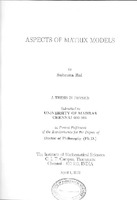- DSpace Home
- →
- IMSc Theses/ Dissertations
- →
- IMSc Theses/ Dissertations
- →
- View Item
JavaScript is disabled for your browser. Some features of this site may not work without it.
| dc.contributor.author | Subrata Bal | |
| dc.date.accessioned | 2009-09-02T07:34:39Z | |
| dc.date.available | 2009-09-02T07:34:39Z | |
| dc.date.issued | 2009-09-02T07:34:39Z | |
| dc.date.submitted | 2002 | |
| dc.identifier.uri | https://dspace.imsc.res.in/xmlui/handle/123456789/100 | |
| dc.description.abstract | The matrix model is an impressive candidate for M-theory (Non perturbative string theory). This thesis investigates the two important aspects of the Physics of Matrix Model, finite temperature matrix model and Fuzzy sphere-Matrix model. This thesis attempts to study the high temperature behavior of a simple, non-trivial system - the system of two D-0-branes. The D-0 brane action is a quantum mechanical one, reduces to a 0+0 dimensional model after compactifying the Euclideanised time, that has the similar structure to that of the IKKT matrix model. The partition function for a system of two D0 brane(D particle) kept at very high temperature is derived up to the leading order in B(beta)-inverse temperature, and exact in coupling constant g. The leading non-trivial term of the partition function is calculated in short distance and large distance limits. The partition function for N = 3 matrix model (IIB) is attempted for calculations as an extension of the present study on 'High Temperature N = 2 matrix model'. The fuzzy sphere in finite matrix model (IIA) correspond to the spherical D-2 brane wrapping on an S^3 in string theory which can be described by the SU(2) WZW model. It is interesting to study the D-branes in curved back ground in the String theory from the matrix model frame work. A general supersymmetric fuzzy sphere model in three dimensions is considered, which allows a multi fuzzy sphere system with discretely arbitrary radii and arbitrary location in R^3. The matrices are artificially partitioned into multiple block diagonal form. The interaction of fuzzy spheres and space points are calculated. The three dimensional fuzzy sphere model is a simple toy model in the context of String theory, and has relevance in other theories like 'the non perturbative regularization of Quantum Field Theory using fuzzy space time' and in studying quantum hall fluids of finite extent using finite matrix model. An extension of such system in 10 dimensions is studied in the context of String Theory. | en_US |
| dc.publisher.publisher | ||
| dc.subject | Matrix Models | en_US |
| dc.title | Aspects of Matrix Models | en_US |
| dc.type.degree | Ph.D | en_US |
| dc.type.institution | University of Madras | en_US |
| dc.description.advisor | Balachandran, Sathiapalan | |
| dc.description.pages | xi; 71p. | en_US |
| dc.type.mainsub | Physics | en_US |
Files in this item
This item appears in the following Collection(s)
-
IMSc Theses/ Dissertations
IMSc Theses/ Dissertations
